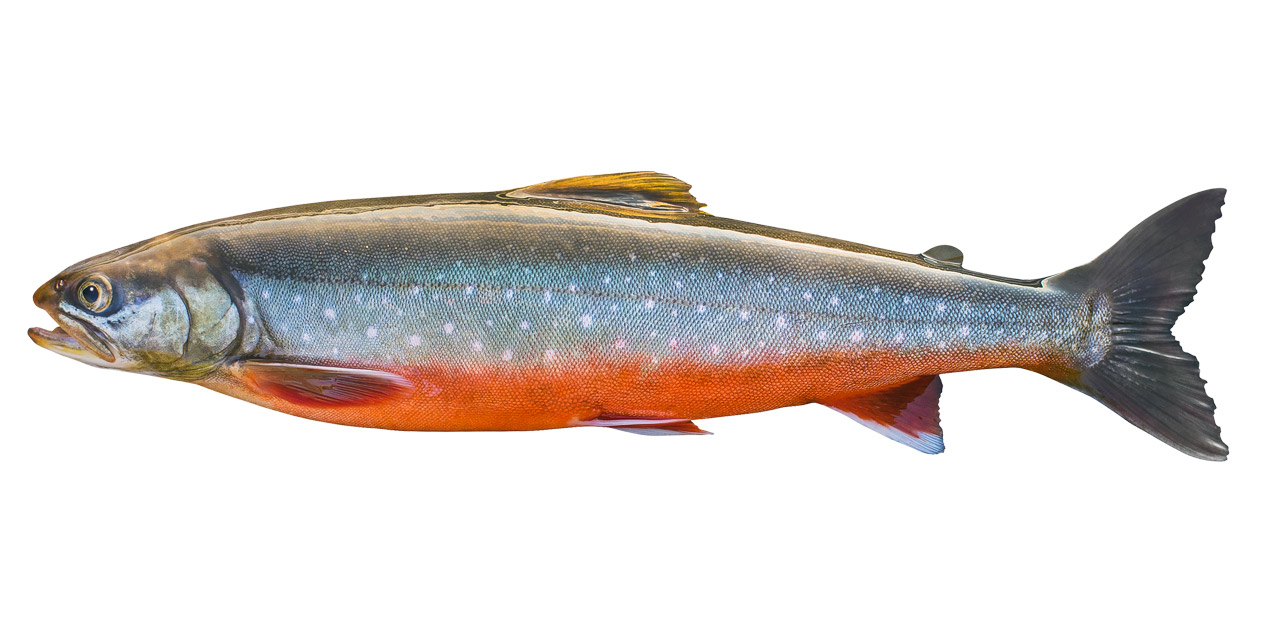Användarmeny
Char ( "Röding") Overview
"Röding") Overview

Char - Salvelinus umbla/alpinus
Char is a natural species in Sweden. It remained when the ice sheet retreated, and is now widespread primarily in the northern and highland parts of Sweden. It thrives best in cold, crystal clear lakes and rivers where it has minimal competition for food. The char is very sensitive to climate change because it needs cold water. It is often said that char is an ice age relic, ie a remnant of a bygone and colder time. Consequently, the char likes cold water, and is the freshwater species found at the far north, and at the top of the watercourses below the glaciers.
The char is a very beautiful fish, although it comes in different shapes, it is best known for its red belly and white fin edges. The color scale can change, however, there are always the white fin edges.
Over the years, science has debated whether it is a char species, or whether there are several, or whether there are so-called related sibling species. The char stocks found in Swedish waters can differ very much in appearance and size between different lakes. This is partly due to different living conditions, and partly because the populations have been different for thousands of years. The scientific name of our original Swedish char is now Salvelinus alpinus, which in principle means (from German) a char that lives in the mountain areas.
Population
In the more southern parts of Sweden, char is found in deep large lakes, such as. Lake Vättern and Sommen, but there are also a number of other and smaller lakes with residual stocks all the way down to Bohuslän, Värmland and Östergötland. Unfortunately, there are also a number of lakes that have recently lost their char stock in modern times. The reason is then eutrophication or acidification, or that competing fish species such as whitefish and vendace have been cleverly introduced. But through eutrophication and overgrowth, predatory fish such as pike have also increased. Excessive fishing pressure has also hurt. This can be easily understood, if you consider that the char live in cold and very nutrient-poor waters, and then have a slow growth.
Although char as an adult is an effective predatory fish that hunts and takes large prey, in the first years it is dependent on zooplankton and very small prey. If there is whitefish and vendace, they easily compete with the juvenile chicks, even if the adult chars like to hunt whitefish and vendace.
The char is a very important fish in Sweden, it is and has been the Sami's most important food fish. The distribution is still good in places where the conditions are good. But in general, the char goes back.
In Norway, for example, there are sea-migrating char stocks, in the same way as sea trout.
Size and growth
The Swedish record is 10.8 kg.
In the Swedish mountains, however, it is unusual for chars over 4 kg.
The really big specimens are usually found in the large deep lakes where the food supplies are good.
The char is playing in the autumn. Then the males become redder and stronger. Rödinglek can be seen in Lake Vättern in the harbor in Huskvarna in the autumn. The spawning fish are then seen very close to the shore, a fantastic spectacle, but where the fish must absolutely not be disturbed or fished on.
Record size
The Swedish record is 10.8 kg, and nearly 90 cm. In the Swedish mountains it is unusual for trout above 4 kg. The really big specimens are usually found in the large deep lakes where födotillgångarna are good.
Fishing tips
The char has made itself known for being difficult to catch. It can be really picky with food, many fly fishermen have torn their hair in despair over how the char constantly avoided the fly even though it is identical to the real one and perfectly placed. A tip if you want to fool the char is to be patient. It usually goes in so-called foraging by circulating a body of water, and often in shoals. If you dot the shoal, you can have a very good fishing. If you miss the shoal, you can wait until it comes back again. The char is fished with different methods, such as fly fishing and spin. A new method that has become popular after char is vertical fishing.
A handful of Swedish fish farms raise char for planting in sport fishing waters. There has also been a processing of char, in order to be able to grow food fish. These also work well as sport fish if they are released into sport fishing waters.

